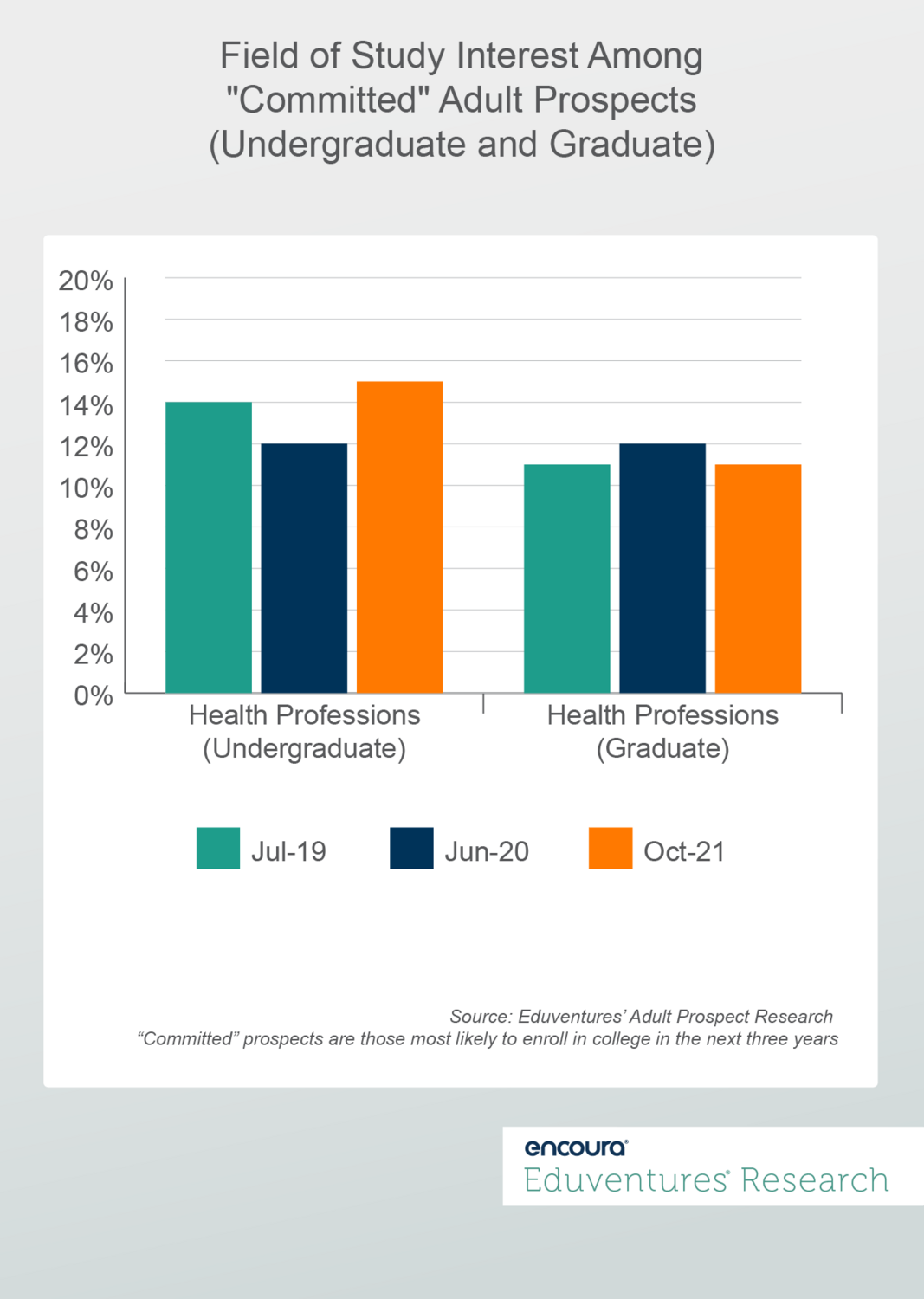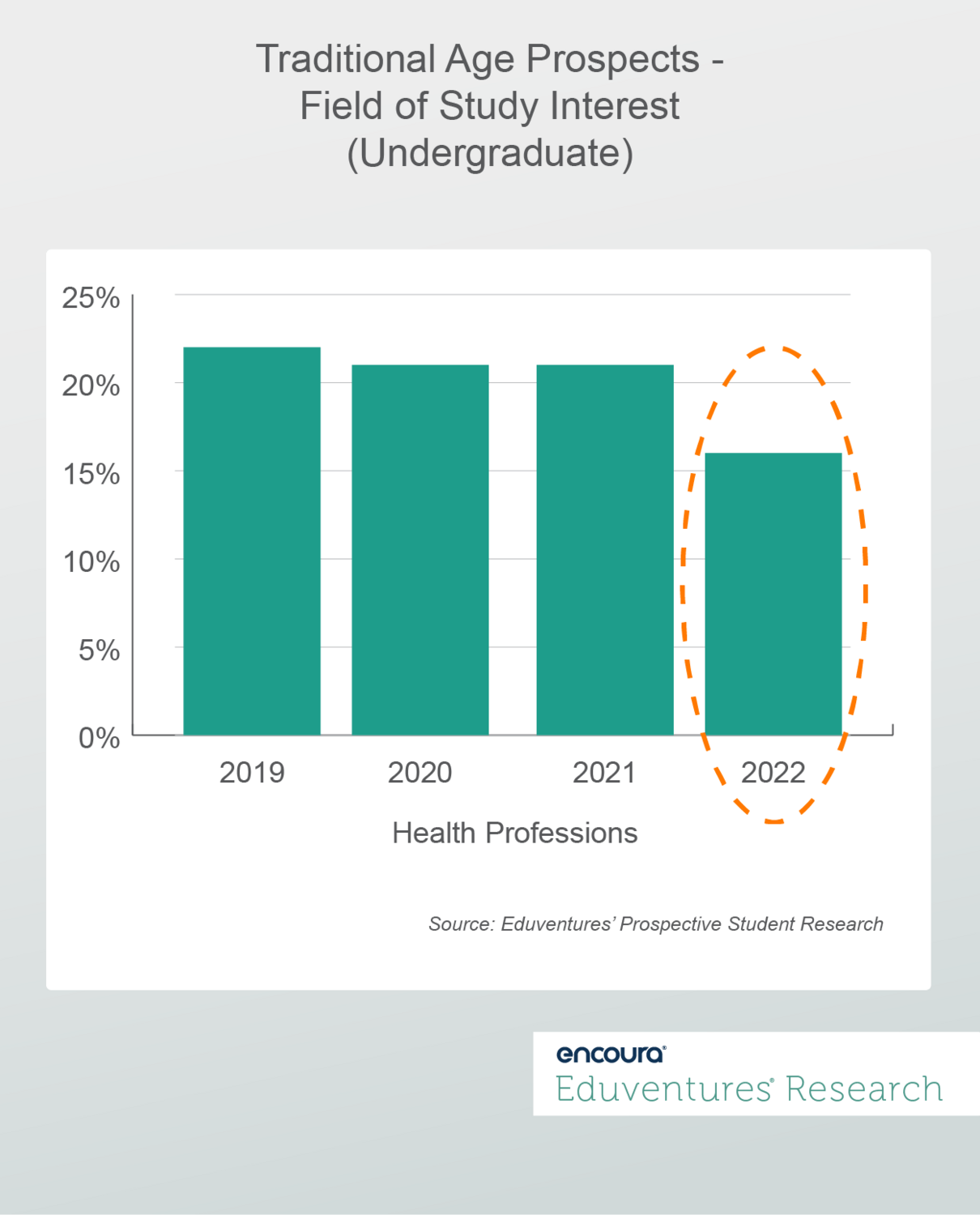This time last year, mid-pandemic, Eduventures published a Wake-Up Call on the health-aligned academic market. This post concluded that demand for health programs was spiking despite COVID-19 and its intense pressures on our healthcare system and professionals.
A year later, with a fresh crop of data available, what better time to revisit the health-related program market. Now that we are “post-pandemic,” where do market signals point today?
Looking Back
Last year’s health market post detailed rapid growth seen in the bachelor’s-and-above health degree market over the last decade and its momentum in the face of COVID-19. It pointed to several health-aligned associations signaling positive market indicators, including the American Association of Colleges of Nursing (AACN) and the Association of Schools and Programs of Public Health (ASPPH). These organizations have now provided some updated information:
Nursing
Last summer’s outlook: In April (2021), AACN reported that enrollment across baccalaureate, master’s, and doctoral nursing programs increased in 2020 “despite concerns that the pandemic might diminish interest in nursing careers.” Based on its Fall 2020 survey of 956 nursing schools, year-over-year enrollment increases were observed in baccalaureate (5.6%), master’s (4.1%), and doctoral (8.9%) nursing programs.
Update: In April 2022, AACN reported that, “enrollment in entry-level baccalaureate nursing programs increased by 3.3% in 2021, despite concerns that the pandemic might discourage career seekers from entering the profession.” But its newest data report wasn’t all rosy. While entry-level bachelor’s nursing enrollment was up, RN-to-BSN program enrollment was down (-9.6%). AACN is investigating causes for this drop, but two theories immediately come to mind:
- As more nurses enter the profession through entry-level bachelor’s programs, the pool of RN’s naturally decreases in size.
- The incredible stress caused by COVID-19 on our healthcare professionals affected current RN’s more than aspiring nurses, potentially driving long-term career investment down; 32% of RN’s surveyed in November 2021 said they may leave their current roles, according to McKinsey and Company.
Medicine
Last summer’s outlook: The Association of American Medical Colleges (AAMC) reported a modest increase of first-year student enrollments in U.S. medical schools for the 2020-2021 academic school year. Medical school applications for the 2021-2022 academic year, however, were up by a significant 18% at the time of our Wake-Up Call’s publication.
Update: In December 2021, AAMC confirmed the 2021-2022 school year saw a record-setting 17.8% application increase leading to the largest and most diverse first-year medical school class in history. These increased application figures are attributed to pandemic-related influences such as remote interviews saving applicants time and money and allowing them to apply to more schools.
While official data is not yet available, AAMC reports that applications for the 2022-23 school year look more like pre-pandemic levels. So, with some new data to inform our outlook, it appears that But coming back down to earth for a market seeing such strong and sustained growth before the pandemic doesn’t necessarily point to future market decline. Rather, the market is more likely normalizing after unprecedented events.
What about Demand?
Figure 1 plots interest in health programming among adult prospects, both undergraduate and graduate, from July 2019, a pre-pandemic baseline, to October 2021, our most recent Adult Prospect Research™ Survey study.

Figure 1 tells a story of slight fluctuation but overall steady health program interest for both sets of adult prospects (undergraduate and graduate). This is notable given larger shifts seen among adult prospects in other fields. For example, interest in business programming declined from 23% pre-pandemic to 17% in October 2021, and interest in education programming declined from 12% pre-pandemic to 7% in October 2021.
Health has historically been the top field of interest for traditional-aged prospects as well. One in five college-bound high school students expressed interest in this field in both 2020 and 2021. But Eduventures’ 2022 Prospective Student Research™ shows an interesting shift in 2022 (Figure 2).

While consistently claiming over 20% of prospective student interest pre- and early pandemic, our 2022 survey found that only 16% of traditional-aged prospects were interested in majoring in health-aligned programming (with gains observed in biological sciences and engineering). While health remained the top field of interest in 2022, this shift will be one worth tracking over time; one year alone is not enough to inform whether a trend is developing.
This year’s drop may be best explained by the loss of career-oriented students in the college-bound pipeline. Many career-oriented prospects are first-generation, low-income, and/or underrepresented minorities, and throughout the pandemic these students have put off college plans and turned to the workforce in greater numbers. Prior to the pandemic, these students demonstrated above-average interest in the health professions. But with fewer of them in the college pipeline and with health-interest slightly softening among this population, we can explain a significant part of 2022’s drop.
Of note, parents of college-bound high school sophomores, juniors, and seniors report a high preference for their children pursuing health programming. In Eduventures’ 2022 Prospective Parent Research™ Survey, the first year this research was conducted, 19% of parents indicated they wanted their children to study health – the highest rated field. Given the critical role parents play in the college search process, this will be another important data point to track over time.
The Bottom Line
Since last year, new developments in the health-aligned program market have taken shape. Nursing enrollment, which surged across the board in 2020, revealed more of a mixed picture in 2021 depending on credential type. Medical school applications that surged to record highs in 2021 appear to be falling to pre-pandemic levels. Health interest among traditional-aged prospects, while remaining the top field of interest, have softened.
While some of these data points may suggest a turning tide for the health market, it is more likely that they are indicative of the extremely fluid situation we still find ourselves in. More than anything, they suggest that the health degree market is experiencing a period of normalization after a flash of intense momentum.
In the immediate term, schools heavily positioned in the undergraduate health market should recognize some of the critical underlying demographic changes in the college-bound pipeline. Now is a good time to assess whether your value proposition for health programs still holds up for those career-oriented students deciding between college and immediate workforce entry.
Never Miss Your Wake-Up Call
Learn more about our team of expert research analysts here.
Eduventures Senior Analyst at Encoura
Contact
Over the past three years, Eduventures has developed a behaviorally and attitudinally-based market segmentation of college-bound high school students we call Student Mindsets™. This year, the sample of nearly 40,000 respondents was drawn from the myOptions® database of college-bound high school juniors and seniors as well as institutional inquiry lists, allowing us to refine and validate the Mindsets in a national sample of unprecedented breadth and depth.
These market “Mindsets” get at students’ imagined paths through college by assessing the desired outcomes of college, perceived importance of college experiences, and key decision criteria at time of application.
The fundamental purpose of the Eduventures Prospective Student Research is to help institutions better understand how college-bound high school students approach one of the most important decisions of their young lives. For a teenager, the college decision looms as a complex make-or-break moment, a pivotal turn on an imagined path to adulthood.
The Program Strength Assessment (PSA) is a data-driven way for higher education leaders to objectively evaluate their programs against internal and external benchmarks. By leveraging the unparalleled data sets and deep expertise of Eduventures, we’re able to objectively identify where your program strengths intersect with traditional, adult, and graduate students’ values, so you can create a productive and distinctive program portfolio.

